Rome in the Early Republic (509 - 241 BC)
Temple of Faunus


Rome in the Early Republic (509 - 241 BC)
Temple of Faunus
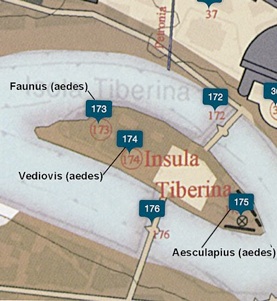
Site of the temple of Aesculapius and
possible sites of the temples of Faunus and of Vediovis on the Tiber Island
Adapted from the website of Digital Augustan Rome
Livy recorded the construction and dedication of this temple in two related passages:
In 197 BC:
“The plebeian aediles, Cn. Domitius Ahenobarbus and C. Scribonius Curio, brought many pecuarii (grazers of animals) to trial before the people: three of them were convicted and [the aediles] used the money that they paid as fines to build a temple to Faunus on the [Tiber] Island”, (‘History of Rome’, 33: 42: 9).
In 194 BC, one of these aediles, Domitius:
“... dedicated [this temple] while city praetor”, (‘History of Rome’, 34: 53: 4).
The fasti Antiates Maiores record the dies natalis of the temple on 13th February and fasti Via Principi Amedeo give its location as ‘Fauno [i]n insula’. (See also Ovid’s reference below to sacrifices here on 13th February).
Cult of Faunus
According to Varro:
“Fauni [Fauns] are deities of the Latins, and can be male or female (Faunus and Fauna). In so-called Saturnian verses, tradition has it that, in woodland places, they used to speak (fori, foretell) the future, from which ‘speaking’, they were called Fauni” , (‘On the Latin Language’, 7: 36, based on the translation by Roland Kent, referenced below, at p. 303).
Eric Olin (referenced below, 2010, at p. 181) characterised Faunus as:
“... an ancient Italic god of the countryside, whom mythology turned into the father of [King] Latinus, that aetiological father of the Latins ... ”
Hélène Moreau (referenced below, at p. 175) argued that:
“The association of the name of Faunus with that of the Latins shows that the god was considered to be a deity of local origin, who must have appeared very early in the Roman pantheon, albeit that his origins are very uncertain: he appears in a number of important episodes of the life of Romulus and Remus, in close connection with the legend of foundation ... of Rome, [and] seems to be the only god whom [the twins] worshiped during their youth, ... while they lived among the shepherds. In this context, Faunus is the god of everything that is the opposite of the city: wild spaces, pastures, mountains, forests ... [and] also of cultivated fields ... Faunus appears as the god of a society with a pastoral, pre-agricultural economy, like that of the first inhabitants of Latium. Consequently, his role in the Roman pantheon was to ensure the protection of farmers and breeders of animals ... ”, my translation).
Penelope Davies (referenced below, at p. 83) observed that the Second Punic War had weighed most heavily on the populus:
“ ... whose old concerns [regarding the] disruption of agriculture and debt had resurfaced: [in order to court their political support, the], aediles [Domitius and Scribonius] pursued those whose misconduct had exacerbated [these] problems, and especially honoured the nature god Faunus , who could oversee the regulation of pastureland.”
John Briscoe (referenced below, at p. 330) pointed out that:
“... the fact that the [fines paid by] only three men were sufficient to provide enough money to build a temple suggests that [they] were not humble shepherds: we are dealing with large-scale operators, [who] had presumably either occupied ager publicus without permission or broken the law concerning the number of animals that could be grazed.”
Vitruvius and the Temple of Faunus
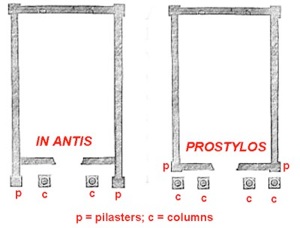
From J. Gwilt (translator), referenced below, my additions in red
These illustrations are at p. 93 in the version republished in 2021 as ISBN-13 : 979-8597820705
Vitruvius seems to have referred to this temple in a passage in which he classified Roman temples in terms of the layout of their pronaoi (porches):
“A temple is called IN ANTIS when it has antæ or pilasters in front of the walls that enclose the cella, [together] with two columns [placed] between the antæ and crowned with a pediment ... The PROSTYLOS temple is similar, except that it has columns instead of antæ in front, which are placed opposite antæ at the angles of the cella. [These columns] support the entablature, which returns on each side, as in those in antis. An example of the prostylos exists in the temple of Jove and Faunus on the Tiber Island”, (‘On Architecture’, 2: 3: 2-3, based on the translation of Joseph Gwilt, referenced below).
Some scholars argue that Vitruvius must have referred here to two separate temples, since no other surviving source refers to a Roman temple dedicated to both Jupiter and Faunus. Thus, for example, Hélène Moreau (referenced below, at pp. 141-2) argued that, although, in Vitruvius’ passage, the cults of:
“... Jupiter and Faunus seem to be housed in the same aedes, this is certainly a mistake:
✴Livy’s record of the [dedication] of the Temple of Faunus [on the island in 194 BC] is clear; and
✴the god Faunus in insula is mentioned alone in the fasti via Principi Amedeo on the [13th] of February”, (my translation).
She concluded that the putative second temple in Vitruvius’ account must have been this temple of Faunus. However, other scholars argue that:
✴Vitruvius would have known whether there was one prostyle temple on the island or two; and
✴there is no basis for emending the surviving manuscripts so that this passage refers to separate temples of Jove and of Faunus.
Thus, for example, Adam Ziolkowski (referenced below, at p. 166, note 14) concluded that, although the text is ambiguous, Vitruvius probably referred to a single temple and suggested that the temple of Faunus that was dedicated on 13th February was dedicated to Jupiter as well. Lawrence Richardson (referenced below, at p. 148) similarly assumed observed that:
“The temple [of Faunus] was a tetrastyle prostyle ... , and Vitruvius says that Jupiter and Faunus were worshipped together there.”
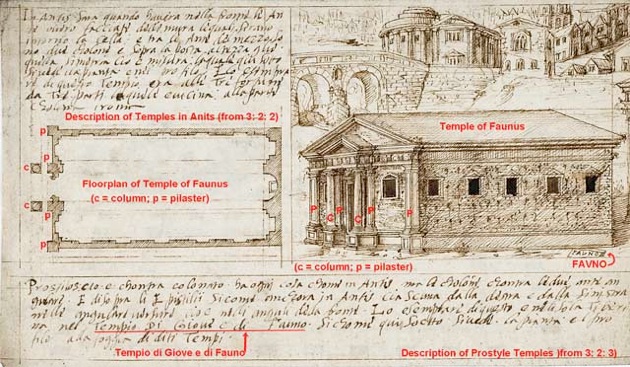
One of eight surviving sheets from an Italian edition (16th century) of Vitruvius’ ‘On Architecture’
The text at the top left summarises 3: 2: 2 (temples in antis), and that below summarises 3: 2: 3 (prostyle temples),
with the ‘Tempio di Giove et di Fauno” given as an example
From the website of the Metropolitan Museum, New York, my additions in red
The sheet illustrated above might throw some light on the matter. It was one of eight sheets from the manuscript draft of an Italian edition of Vitruvius’ ‘On Architecture’ that were acquired by the Metropolitan Museum, New York, in 2007 BC, as recorded by Carmen Bambach (referenced below). She attributed them a member of the Sangallo family and dated them to 1530-50. This sheet illustrates the temple of Faunus (identified at the lower right) in front of one of the the bridges of the Tiber Island, with its floor plan to the left. The text below summarises Vitruvius’ description of prostyle temples (albeit that the form of the temple, as he represented it, has only two columns in front of the facade, as opposed to the Vitruvian four). In this Italian text, Vitruvius’ Roman example of this style is rendered as ‘[il] Tempio di Giove e di Fauno’, suggesting that ‘Sangallo’, like Ziolkowski and Richardson above, assumed that Vitruvius gave this dedication to the temple that was generally known as the temple of Faunus. (Unfortunately, I am unable to read the most of Italian text in the bottom box, which might throw further light on how ‘Sangallo’ interpreted this passage).
In summary, it is possible that Vitruvius identified two prostyle temples on the island:
✴a temple of Jupiter (perhaps indicating the temple of Vediovis, the young Jupiter) which was dedicated on the island on 1st January 194 BC - see my page on the Temple of Vediovis on the Tiber Island); and
✴the temple of Faunus, which was dedicated some six weeks later, of 13th February 194 BC.
However, Vitruvius' original text almost certainly referred to a single temple of Jove and Faunus. A Roman temple of this dedication is otherwise unknown, but it is possible that a cult site devoted to Jupiter was subsequently housed within this temple of Faunus.
Location of the Temple of Faunus
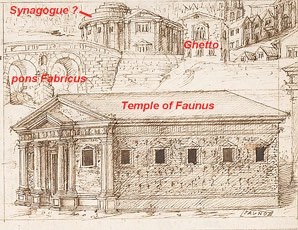
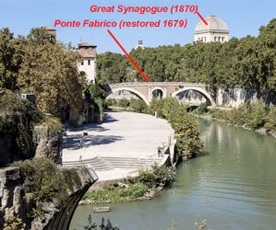
Temple of Faunus (ca, 1540) Northern tip of Tiber Island and Ponte Fabrico
(Detail of illustration above). From the website of Jeff Bondono
Ovid recorded that:
“On the [13th February], the altars of rustic Faunus smoke [during sacrifices, in the place] where the [Tiber] island breaks the parted waters”, (‘Fasti’ 2: 193-4, based on the translation of James Frazer, referenced below, at p. 71).
Paolo Carafa and Paola Pacchiarotti (referenced below, at p. 553 and p. 570, note 108) suggested that Ovid’s reference to the place ‘where the island breaks the parted waters’ indicated that the temple was located at the island’s northern point. They pointed out (at p. 570, note 108, citing Maurice Besnier, referenced below) that:
“The remains of walls and large marble blocks that were still visible here in the 16th and 17th centuries might have been associated with this temple”, (my translation).
Any trace of this temple has since disappeared, but the illustration by ‘Sangallo’ suggests that there was evidence of its location here in ca. 1540: indeed, it is possible that the drawing reflects the structure as it survived at that time. It is also placed in this location on the map in the the website of Digital Augustan Rome, as illustrated at the top of the page.
Read more:
Davies P., “Architecture Politics in Republican Rome”, (2017) Cambridge
Moreau H., “Entre Deux Rives- Entre Deux Ponts: l’ Île Tibérine de la RomeAantique: Histoire, Archéologie, Urbanisme des Origines au Vè Siècle après J.C”, (2014) thesis of Université Charles de Gaulle, Lille
Carafa P. and Pacchiarotti P., “Regione XIV: Transtiberium”, in:
Carandini A. (editor), “Atlante di Roma Antica”, (2012) Rome: Vol. 1 pp 549-82; and Vol. 2, Map 247
Orlin E., “Foreign Cults in Rome: Creating a Roman Empire”, (2010) Oxford
Bambach C., “Recent Acquisition: Attributed to the Sangallo Family: Temple Types In Antis and Prostyle”, Metropolitan Museum of Art Bulletin, 66:2 (2008) 16
Richardson L., “A New Topographical Dictionary of Ancient Rome”, (1992) London
Ziolkowski A., “The Temples of Mid-Republican Rome and their Historical and Topographical Context”, (1992) Rome
Briscoe J., “A Commentary On Livy: Books 31-33”, (1973) Oxford
Kent R. (translator), “Varro: ‘On the Latin Language’: Volume I: Books 5-7”, (1938) Cambridge MA
Frazer J. (translator, revised by G. P. Goold), “Ovid: ‘Fasti’”, (1931), Cambridge MA
Besnier M., “L' Íle Tibérine dans l' Antiquité”, (1902) Paris
Gwilt J. (translator), “Vitruvius: De Architectura (Illustrated)”, (1826) London, republished as ISBN-13 : 979-8597820705 in 2021)
RReturn to Rome in the Early Republic (509 - 241 BC)